Noxious Weeds
Type A Noxious Weeds
Myrtle Spurge
DESCRIPTION: Low growing, 4-8” tall with 18” spread. Flowers yellow-green with heart-shaped bracts. Trailing stems with fleshy blue-green alternate leaves. Taproot. Leaves and stems have toxic milky sap that is poisonous; can cause skin irritations, nausea, vomiting, and diarrhea.
Blooms: Perennial. Early spring, March –May.
Reproduces: By seed and can spread vegetatively. Seed heads are explosive and can project seeds up to 15 ft.
Control Methods: Integrated management is best.
Mechanical: Hand-pullable, but protect skin from sap, bag up entire plant and dispose. Do not leave plant parts on the ground as they could re-propagate. Monitor the area for at least 9 years to ensure the plant is eradicated.
Cultural: Revegetate area with native seed or plants that bloom August-October. Suggested alternatives: Creeping Mahonia, Creeping Sedum, Sulphur Flower, Kinnikinnick, White Horehound.
Biological: None known.
Chemical: Large infestations can be controlled with herbicides.
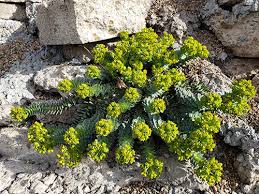
Cypress Spurge
DESCRIPTION: Low growing perennial. Flowers yellow-green and similar looking to myrtle spurge, but leaves are linear. Taproot. Leaves and stems have toxic milky sap that is poisonous; can cause skin irritations, nausea, vomiting, and diarrhea.
Blooms: Perennial. Early spring, March-May
Reproduces: By seed and can spread vegetatively. See heads are explosive and can project seeds up to 15ft.
Control Methods: Integrated management is best.
Mechanical: Hand-pullable, but protect skin from sap, bag up entire plant and dispose. Do not leave plant parts on ground as they could re-propagate. Monitor the area for at least 9 years to ensure the plant is eradicated.
Cultural: Revegetate area with native seed or plants that bloom August-October. Suggested alternatives: Creeping Mahonia, Creeping Dedum, Sulfur Flower, Kinnikinnick, White Horehound.
Biological: None known
Chemical: Large infestations can be controlled with herbicides.
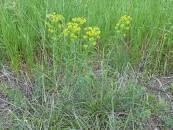
Orange Hawkweed
DESCRIPTION: Grows 10-20” tall. Flower ½-3/4” wide, bright orange with notched tips, resembling dandelions. Clusters of 5-35 flowers on top of stem, and tend to close up in shade, making the plant difficult to see. Leaves area basal, one or two small leaves may occur on the slender, bristly stem. Rosette leaves are 4-6” in length, spatula shaped, finely toothed margins.
Blooms: Creeping perennial. Flowers June-July.
Reproduces: from runners, rhizomes, sporadic root buds and seed.
Control Methods: Integrated management is best.
Mechanical: Very difficult to eliminate solely by hand-pulling. Bag and dispose entire plant if flowering.
Cultural: Revegetate area with native seed or plants that bloom in August-October. Suggested alternatives: Wallflower, Globemallow, Poppies.
Biological: None Known
Chemical: Herbicides at the bud stage is the best method for elimination.
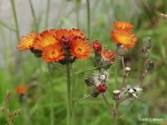
Bull Thistle
DESCRIPTION: In Colorado, Bull thistles are the only species that are prickly hairy on the top and are cottony-hairy on the undersides of the leaves. In mature plants the leaves extend down, clasping the stem and are divided into segments.
Blooms: Gumdrop shaped pinkish to dark purple 1 ½-2” in diameter. Flowers June-July. Seeds set in July-August.
Reproduces: Biennial. Spiky rosettes first season, flowers second season.
Control Methods:
Mechanical: Because biennial thistles do not reproduce from their roots, any mechanical or physical method that severs the root below the soil surface will kill the weed.
Cultural: Revegetate area with native seed or plants that bloom July-September. Suggested alternatives: Rocky Mountain Bee Plant, Purple Coneflower (Echinacea), Garden Phlox.
Biological: None known
Chemical: Not needed, if mechanical methods are used.
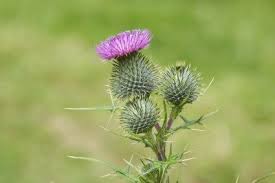
Canada Thistle
DESCRIPTION: Grows 2-4 ft. tall. Flowers pink, purple, ½-3/4” wide. Clusters of 1-5 small flowers per branch. Stems erect, hollow, lower covered with fine hairs. Leaves lance shaped, spine tipped lobes, hairless or fine hairs. Rosette at bottom is spiny-tipped with wavy leaves. Roots extensive, fleshy, creeping, forming colonies.
Blooms: Creeping perennial. Rosette every spring. Flowers June-October.
Reproduces: By seed and deep, reproducible roots that spread horizontally 18 feet in one season. 75% of Canada thistle plant is underground.
Control Methods:
Mechanical: Mow May-September just before flowering. If flower heads are purple or have gone to seed, bag and dispose flower heads first before mowing. Aim to exhaust the seed bank. Shallow tillage only increases the number of plants.
Cultural: Revegetate area with native seed or plants that bloom July-September. Suggested alternatives: Rocky Mountain Bee Plan, Purple Coneflower (Echinacea), Garden Phlox.
Biological: None known
Chemical: Herbicides are the best method for elimination
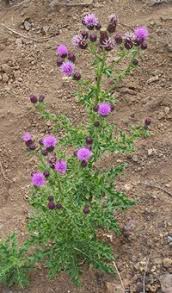
Musk Thistle
DESCRIPTION: Grows 2-6 ft. tall. Flowers 1 ½-3” wide, pinkish-purple, with pinecone-like prickly bracts below. 1 or more stems from base highly branched above, one flower per stem. Leaves waxy, alternate, extending down stem, dark green, deeply lobed, spines on edges, white edges and midribs. Rosettes densely hairy. Taproot.
Blooms: Biennial. Spiky rosettes first season, blowers second season, late May-June. Seeds set June-July.
Reproduces: Only by seed.
Control Methods:
Mechanical: Pull entire plant before flowering. Otherwise, clip and bag flowers while leaving the reset of the plan on ground to decompose. Aim to exhaust the seed bank.
Cultural: Revegetate ar3ea with native seed or plants that bloom in May-September. Suggested alternatives: Rocky Mountain Bee Plant, Purple Coneflower (Echinacea), Garden Phlox.
Biological: None known
Chemical: Apply herbicide when the plants are approximately 1” tall. If flower heads are purple or have gone to seed, clip and bag flower heads first.
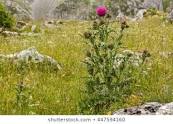
Oxeye Daisy
DESCRIPTION: Grows 10-24” tall. Large 2” daisy-style flower with yellow center and white petals, singular flower at end of stem. Leaves are deeply toothed. Lower leaves spoon-shaped, upper leaves are narrow and clasp the stem, increasingly less leaves at top of stem. Rosette at bottom. Creeping root system.
Blooms: Creeping perennial. Flowers June-August
Reproduces: by seed and underground rhizomes.
Control Methods:
Mechanical: Hand pull or dig when soil is moist and infestations are small. Oxeye daisy is fairly shallow rooted, make sure to pull up all of the roots. Clip and bag flowers while leaving the rest of plant on ground to decompose. Aim to exhaust the seed bank.
Cultural: Revegetate area with native seed or plants that bloom in May-September. Suggested alternatives: Coulter Daisy, Showy Daisy, Marguerite Daisy, White or Purple Coneflower.
Biological: None known
Chemical: Larger infestations may require chemical control to effectively control this plant.
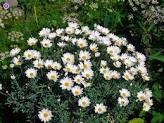
Scentless Chamomile
DESCRIPTION: Grows 6-30” tall. Small ¾” daisy-style flower with yellow center and white petals. Leaves fern-like, feathery, alternate, busy appearance. Stems erect and smooth. Roots fibrous. Differs from the chamomile used in tea because its flowers, leaves lack odor, flavor. Irritates mucous membranes of livestock.
Blooms: Annual. Flowers early summer until frost.
Reproduces: only by seed
Control Methods:
Mechanical: Hand pulling can prevent spread into new areas and effective on small infestations. If pulled before flowering, can be left on ground to decompose, otherwise, must be bagged and disposed. Aim to exhaust the seed bank. Frequent, shallow tillage can help exhaust the seed bank. Mowing is not an effective long-term control method due to the fact the plant will grow prostate and bloom. However, in the short-term mowing will assist with limiting seed production.
Cultural: Revegetate area with native seed or plants that bloom in May-September. Suggested alternatives: Pearly Everlasting, White Columbine, White Coral Bells, and Feverfew.
Biological: None known
Chemical: Can be controlled with herbicides.
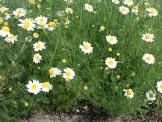
Scotch Thistle
DESCRIPTION: Grows up to 12’ tall, branching, and can be quite dense. Flowers reddish-purple to violet, numerous, 1-2 inches in diameter, with spine-tipped bracts. Leaves hairy, up to 1 ft. wide and 2 ft. long Rosettes up to 2 ft. diameter. Fleshy taproot.
Blooms: Biennial. Rosette in spring or fall of first year. Flowers mid-June to September of second year.
Reproduces: Only by seed. Can produce up to 14,000 seeds per plant.
Control Methods:
Mechanical: Hand-pullable, best controlled in the rosette stage by severing its taproot 1-2 inches below the ground.
Chemical and Cultural Integrated management: One integrated approach to Scotch thistle management involves 1) incorporate livestock grazing to increase grass vigor and reduce bare ground; 2) spray rosettes with herbicide; 3) re-seed treated ground with competitive desirable plants in the fall after spraying. Suggested alternatives: Rocky Mountain Bee Plant, Purple Coneflower (Echinacea), Garden Phlox; 4) Follow up with spot cutting of entire plants when first flowers appear annually for several years to deplete the seed bank in the soil.
Biological: None known

